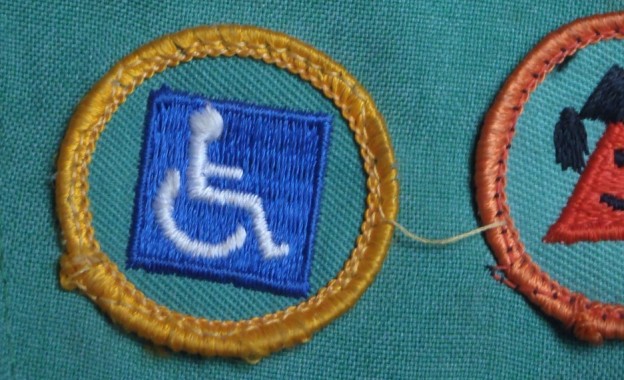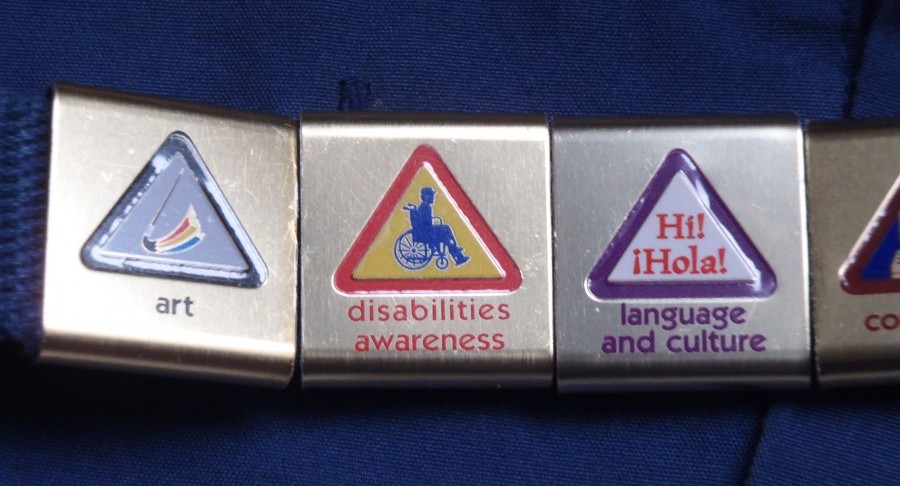
Resources  To earn his belt loop in Disabilities Awareness, my scout had to complete 3 requirements:
1. Meet a person with a disability and learn about his life.
My son listened to his brother talk about what he enjoys doing and what he needs help with.
2. Make a poster about a disability and explain it to your Cub Scout den.
With his fellow scouts, my son made a poster about autism with 3 columns (“People with autism can…,” “People with autism might need help with…” and “I can help by…”) Every scout added ideas to each column.
3. Attend or participate in a disability-related event.
This could be a Special Olympics event, a wheelchair basketball game, an awareness walk or a ceremony for disabled veterans. We chose to form a family team and participate in the Walk For Friendship.
To earn his belt loop in Disabilities Awareness, my scout had to complete 3 requirements:
1. Meet a person with a disability and learn about his life.
My son listened to his brother talk about what he enjoys doing and what he needs help with.
2. Make a poster about a disability and explain it to your Cub Scout den.
With his fellow scouts, my son made a poster about autism with 3 columns (“People with autism can…,” “People with autism might need help with…” and “I can help by…”) Every scout added ideas to each column.
3. Attend or participate in a disability-related event.
This could be a Special Olympics event, a wheelchair basketball game, an awareness walk or a ceremony for disabled veterans. We chose to form a family team and participate in the Walk For Friendship.
How Scouts Can Earn A Disability Awareness Badge
When I was a Girl Scout many years ago, I was the type who would comb through the handbook looking for more badges that I could earn on my own, such as math skills or local history. My troop was very active, and we enjoyed some memorable experiences together as we explored career options, community service projects, life skills and academic topics. One time my troop leader invited a reporter from the New York Times to speak to our group.This reporter had cerebral palsy and used a wheelchair, so she explained how she did her job with accommodations. She opened our young minds to possibilities that we hadn’t considered before. After completing several other activities to learn about disabilities, we earned a merit badge in Disabilities Awareness.Girl Scouts of the USA
Today the Girl Scouts of the USA still offer participation patches for ability awareness and inclusion. The requirements vary from one local council to another, but they may be completed by scouts at all levels from Daisies to Ambassadors.Depending on their rank, the scouts must select up to 9 activities from a menu in order to earn the patch. Some examples of these activities may be:- Practicing person-first language
- Reading and discussing on-topic books
- Visiting public buildings and identifying accommodations for people with disabilities
- Identifying supports available to students with special needs at school
- Learning American Sign Language (ASL)
- Learning the braille alphabet
- Discussing the talents and compensation strategies of famous people who have disabilities, such as Juliette Gordon Low (founder of Girl Scouts), Stephen Hawking, Temple Grandin, Franklin Delano Roosevelt, Walt Disney, Helen Keller and Henry Winkler
- Practicing using a wheelchair, walking with a blindfold and/or communicating without words
- Visiting a social service agency that assists people with disabilities
- Interviewing a person with a disability and/or a person who works with people with disabilities
- Learning how to be a friend to a person with a disability
Boy Scouts of America
These learning opportunities are not limited to the Girl Scouts. The Boy Scouts of America have national requirements for scouts ages 6 to 18 to earn a belt loop, academic pin and merit badge in Disabilities Awareness. My younger son is a Cub Scout intent on earning as many awards as possible. This year I guided him as he earned his belt loop and academic pin for Disabilities Awareness. Because his older brother has a developmental disability, he had a head start in understanding the topic, and we already had connections in the community to help him complete the requirements. Each activity is designed to help the child consider his own role as a citizen and friend, career opportunities in the field, and develop his knowledge of the world.Belt Loop
 To earn his belt loop in Disabilities Awareness, my scout had to complete 3 requirements:
1. Meet a person with a disability and learn about his life.
My son listened to his brother talk about what he enjoys doing and what he needs help with.
2. Make a poster about a disability and explain it to your Cub Scout den.
With his fellow scouts, my son made a poster about autism with 3 columns (“People with autism can…,” “People with autism might need help with…” and “I can help by…”) Every scout added ideas to each column.
3. Attend or participate in a disability-related event.
This could be a Special Olympics event, a wheelchair basketball game, an awareness walk or a ceremony for disabled veterans. We chose to form a family team and participate in the Walk For Friendship.
To earn his belt loop in Disabilities Awareness, my scout had to complete 3 requirements:
1. Meet a person with a disability and learn about his life.
My son listened to his brother talk about what he enjoys doing and what he needs help with.
2. Make a poster about a disability and explain it to your Cub Scout den.
With his fellow scouts, my son made a poster about autism with 3 columns (“People with autism can…,” “People with autism might need help with…” and “I can help by…”) Every scout added ideas to each column.
3. Attend or participate in a disability-related event.
This could be a Special Olympics event, a wheelchair basketball game, an awareness walk or a ceremony for disabled veterans. We chose to form a family team and participate in the Walk For Friendship.



